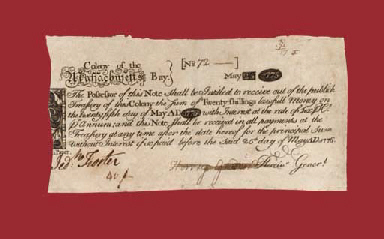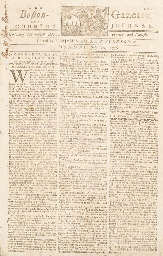LEXINGTON and CONCORD]. Bloody Butchery by the British Troops, or, The Runaway Fight of the Regulars. Being the Particulars of the Victorious Battle fought at and near Concord...between Two Thousand Regular Troops, belonging to His Britannick Majesty, and a few Hundred Provincial Troops... , Salem, N.E.: Printed and Sold by E[zekiel] Russell., [May 1775]. Printed broadside, folio, 500 x 380 mm (19¾ x 15 in). Printed in three columns, woodcut mourning borders and column divisions, at top two rows of forty woodcut coffins (each captioned with the name of an an American casualty), six small boxes along bottom containing "A Funeral Elegy, to the I[m]mortal Memory of those Worthies who were Slain in the Battle of Concord," woodcut border surrounding initial capital "O" in first column. (Browned, backed with linen, crack along central vertical fold with loss of a letter in several lines, marginal chips and tears not affecting text.) "BLOODY BUTCHERY": AMERICAN REVOLUTIONARY PROPAGANDA IN THE AFTERMATH OF "THE SHOT HEARD ROUND THE WORLD" A remarkable broadside, justly famous for its powerful graphics, its detailed narrative of the day-long battles of Lexington and Concord, and its stirring call to patriots to take arms against British tyranny. The printer, Ezekiel Russell, was strongly supportive of the revolutionary cause; he later issued a broadside account of Bunker Hill and, later still, the first Salem edition of the Declaration of Independence. Russell created "Bloody Butchery," a highly effective piece of anti-British propaganda, by uniting several texts: a first report on the battles, datelined 21 April (from Russell's own Salem Gazette ), a follow-up datelined 25 April (excerpted from the rival Salem Essex Gazette ), a 5 May report on the American casualties and funerals, and, in column three, a detailed "List of the Provincials who were Killed or Wounded," arranged by the towns in which they resided (8 names are marked with an asterisk, to denote those "killed [at Lexington common] by the first fire of the enemy." The anonymous verse elegy at the bottom of the sheet, reprinted from the Newburyport Essex Journal and Merrimack Packet , names most of the towns which suffered in the fighting, and concludes "Your country calls you far and near, America's sons 'wake ...His shield will keep us from all harm, Tho' thousands 'gainst us rise His buckler we must sure put on. If we would win the prize." Russell's headline informs us that "These particulars are now published in this cheap form at the request of the friends of the deceased worthies who died gloriously fighting in the cause of Liberty and their Country; and it is their desire that every Householder in America, who are sincere well-wishers to the American Colonies, may be possessed of the same, either to frame and glass, or otherwise to preserve in their Houses...as a perpetual Memorial of that important event, on which, perhaps, may depend the future Freedom and greatness of the Common-wealth in America..." The broadside evidently proved even more popular than Russell had imagined, and though few copies survive, at least two editions and three issues are distinguished, even though no definite sequence can be deduced. Streeter's "first edition" has no imprint, lacks the initial capital in column one and has a nine-line heading paragraph. The present issue of the second edition adds the initial capital, carries a six-line heading paragraph and has a two-line imprint, another issue features a five-line imprint with the note, "The Second Edition, corrected, with some additions" and shows two additional coffins (representing two Americans who had since died of wounds sustained in the fighting). All versions are quite rare. Copies of the several variantss (some defective) are at Massachusetts Historical Society, Harvard, American Antiquarian Society, Yale, Princeton (Scheide), John Carter Brown (untrimmed margins), New York Public Library; a copy in the British Library (18
LEXINGTON and CONCORD]. Bloody Butchery by the British Troops, or, The Runaway Fight of the Regulars. Being the Particulars of the Victorious Battle fought at and near Concord...between Two Thousand Regular Troops, belonging to His Britannick Majesty, and a few Hundred Provincial Troops... , Salem, N.E.: Printed and Sold by E[zekiel] Russell., [May 1775]. Printed broadside, folio, 500 x 380 mm (19¾ x 15 in). Printed in three columns, woodcut mourning borders and column divisions, at top two rows of forty woodcut coffins (each captioned with the name of an an American casualty), six small boxes along bottom containing "A Funeral Elegy, to the I[m]mortal Memory of those Worthies who were Slain in the Battle of Concord," woodcut border surrounding initial capital "O" in first column. (Browned, backed with linen, crack along central vertical fold with loss of a letter in several lines, marginal chips and tears not affecting text.) "BLOODY BUTCHERY": AMERICAN REVOLUTIONARY PROPAGANDA IN THE AFTERMATH OF "THE SHOT HEARD ROUND THE WORLD" A remarkable broadside, justly famous for its powerful graphics, its detailed narrative of the day-long battles of Lexington and Concord, and its stirring call to patriots to take arms against British tyranny. The printer, Ezekiel Russell, was strongly supportive of the revolutionary cause; he later issued a broadside account of Bunker Hill and, later still, the first Salem edition of the Declaration of Independence. Russell created "Bloody Butchery," a highly effective piece of anti-British propaganda, by uniting several texts: a first report on the battles, datelined 21 April (from Russell's own Salem Gazette ), a follow-up datelined 25 April (excerpted from the rival Salem Essex Gazette ), a 5 May report on the American casualties and funerals, and, in column three, a detailed "List of the Provincials who were Killed or Wounded," arranged by the towns in which they resided (8 names are marked with an asterisk, to denote those "killed [at Lexington common] by the first fire of the enemy." The anonymous verse elegy at the bottom of the sheet, reprinted from the Newburyport Essex Journal and Merrimack Packet , names most of the towns which suffered in the fighting, and concludes "Your country calls you far and near, America's sons 'wake ...His shield will keep us from all harm, Tho' thousands 'gainst us rise His buckler we must sure put on. If we would win the prize." Russell's headline informs us that "These particulars are now published in this cheap form at the request of the friends of the deceased worthies who died gloriously fighting in the cause of Liberty and their Country; and it is their desire that every Householder in America, who are sincere well-wishers to the American Colonies, may be possessed of the same, either to frame and glass, or otherwise to preserve in their Houses...as a perpetual Memorial of that important event, on which, perhaps, may depend the future Freedom and greatness of the Common-wealth in America..." The broadside evidently proved even more popular than Russell had imagined, and though few copies survive, at least two editions and three issues are distinguished, even though no definite sequence can be deduced. Streeter's "first edition" has no imprint, lacks the initial capital in column one and has a nine-line heading paragraph. The present issue of the second edition adds the initial capital, carries a six-line heading paragraph and has a two-line imprint, another issue features a five-line imprint with the note, "The Second Edition, corrected, with some additions" and shows two additional coffins (representing two Americans who had since died of wounds sustained in the fighting). All versions are quite rare. Copies of the several variantss (some defective) are at Massachusetts Historical Society, Harvard, American Antiquarian Society, Yale, Princeton (Scheide), John Carter Brown (untrimmed margins), New York Public Library; a copy in the British Library (18






.jpg)
.jpg)



Try LotSearch and its premium features for 7 days - without any costs!
Be notified automatically about new items in upcoming auctions.
Create an alert